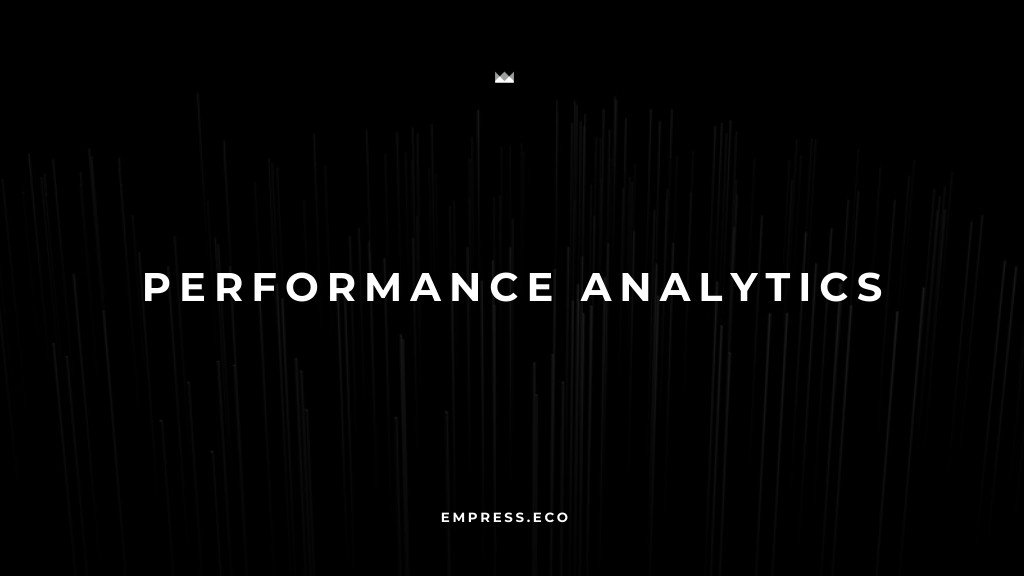
Enhance Business Performance with Sol’s Data-Driven Analytics
Table of Contents
Data is often referred to as the new oil—a precious resource that, when refined and utilized correctly, can propel a business to new heights. Performanceanalytics is the process through which this data is harnessed, systematically analyzed, and translated into actionable insights that drive efficiency, growth, and strategic success. By monitoring key performance indicators (KPIs) and delving into data trends, businesses can not only gauge their current standing but also anticipate future challenges and opportunities.
This article explores the critical role of performance analytics in business, the steps required to implement it effectively, and the challenges that may arise during its application.
The Key Benefits of Performance Analytics
Implementing performance analytics offers a range of benefits that can significantly enhance a business’s operational capabilities and strategic planning. Here’s how:
1. Informed Decision-Making
One of the most compelling advantages of performance analytics is its ability to support informed decision-making. Instead of relying on intuition or anecdotal evidence, businesses can base their strategies on concrete data. This data-driven approach minimizes risks and enhances the accuracy of decisions, leading to better outcomes across the board.
For instance, a retail company might analyze sales data to determine which products are performing well and which are lagging. By understanding these trends, the company can make informed decisions about inventory management, marketing strategies, and product development, thereby optimizing its operations and increasing profitability.
2. Enhanced Efficiency
Efficiency is the backbone of any successful business. Performance analytics enables organizations to identify inefficiencies in their processes by highlighting bottlenecks, redundancies, and underperforming areas. With these insights, businesses can streamline operations, allocate resources more effectively, and ultimately boost productivity.
Consider a manufacturing firm that uses performance analytics to monitor machine performance and production output. By analyzing this data, the firm can identify machines that frequently break down or operate below capacity. The company can then take corrective actions, such as scheduling regular maintenance or upgrading equipment, to enhance overall production efficiency.
3. Goal Alignment
In any organization, aligning day-to-day activities with overarching strategic goals is crucial for success. Performance analytics plays a vital role in ensuring this alignment by continuously monitoring KPIs that reflect the company’s progress toward its objectives. By regularly reviewing these metrics, businesses can stay focused on their goals, make necessary adjustments, and measure the effectiveness of their strategies.
For example, a software development company might track KPIs such as project completion rates, customer satisfaction scores, and revenue growth. By analyzing these metrics, the company can ensure that its development efforts are aligned with customer expectations and business objectives, leading to better project outcomes and higher client retention.
4. Proactive Problem Solving
One of the most powerful aspects of performance analytics is its ability to enable proactive problem-solving. By closely monitoring data, businesses can detect early signs of potential issues, such as declining sales, rising operational costs, or customer dissatisfaction. Addressing these problems before they escalate can prevent disruptions and ensure smooth operations.
For instance, a service-based company might use performance analytics to monitor customer feedback and service response times. If the data reveals a trend of increasing customer complaints or delayed responses, the company can take immediate action, such as retraining staff or optimizing service workflows, to rectify the situation and maintain customer satisfaction.
Implementing Effective Performance Analytics
To fully leverage the benefits of performance analytics, businesses must adopt a systematic approach that involves identifying relevant KPIs, collecting and analyzing data, and fostering a data-driven culture. Here are the steps to implementing performance analytics effectively:
1. Identify Relevant KPIs
The foundation of any successful performance analytics initiative lies in identifying the right KPIs. These metrics should be directly tied to your business objectives and provide insights into the areas that most impact your organization’s success.
For example, if your goal is to improve customer satisfaction, relevant KPIs might include Net Promoter Score (NPS), customer retention rate, and average response time to customer inquiries. If your focus is on increasing profitability, KPIs could include gross profit margin, return on investment (ROI), and operating expenses.
By carefully selecting KPIs that align with your strategic goals, you can ensure that your performance analytics efforts are focused on the most critical aspects of your business.
2. Collect and Analyze Data
Once you’ve identified the relevant KPIs, the next step is to gather data from various sources. This data should be accurate, comprehensive, and up-to-date to provide meaningful insights. Data can come from a range of sources, including internal systems (such as CRM, ERP, and HR systems), external databases, customer feedback, and financial reports.
After collecting the data, use analytical tools and techniques to process and interpret it. This analysis might involve statistical methods, data visualization, and trend analysis. The goal is to uncover patterns, correlations, and insights that can inform decision-making and strategy development.
For example, a marketing team might analyze website traffic data, social media engagement metrics, and conversion rates to determine the effectiveness of a recent campaign. By understanding which channels and content types drove the most engagement and conversions, the team can refine future campaigns to achieve even better results.
3. Leverage Data Visualization
Data visualization is a critical component of performance analytics, as it helps transform complex data sets into easily understandable insights. Visual representations such as charts, graphs, dashboards, and heat maps allow stakeholders to quickly grasp key performance metrics and trends.
For instance, a sales team might use a dashboard to track daily sales performance, broken down by region, product category, and sales representative. This visual tool enables the team to monitor progress in real-time, identify top performers, and address any emerging challenges.
Effective data visualization not only enhances understanding but also facilitates communication among team members and stakeholders, making it easier to collaborate on strategy development and execution.
4. Set Benchmarks and Targets
To gauge the effectiveness of your strategies, it’s essential to establish benchmarks and performance targets. Benchmarks provide a reference point for evaluating current performance, while targets represent the desired outcomes you aim to achieve.
For example, a customer service department might set a benchmark for average response time based on industry standards and internal historical data. The department might then establish a target to reduce response times by 20% over the next quarter. By regularly comparing actual performance against these benchmarks and targets, the department can assess its progress and make necessary adjustments.
5. Foster a Data-Driven Culture
For performance analytics to be truly effective, it must be embraced at all levels of the organization. Fostering a data-driven culture means encouraging employees to use data in their decision-making processes, providing training on data analysis tools and techniques, and promoting transparency in sharing performance metrics.
Leadership plays a crucial role in setting the tone for a data-driven culture. When executives and managers prioritize data-backed decisions and openly discuss performance metrics with their teams, it reinforces the importance of analytics and inspires others to follow suit.
For instance, a company might hold regular meetings to review key performance data, discuss successes and challenges, and explore opportunities for improvement. By making data a central part of the conversation, the organization can drive continuous improvement and align efforts across departments.
Challenges and Considerations
While performance analytics offers numerous benefits, it also presents certain challenges that businesses must navigate to achieve success:
1. Data Quality and Accuracy
The effectiveness of performance analytics hinges on the quality and accuracy of the data being analyzed. Inaccurate or incomplete data can lead to misleading insights and poor decision-making. To address this challenge, businesses must implement processes for data validation, cleansing, and regular audits.
For example, a financial services firm might establish protocols for verifying the accuracy of transaction data before it is entered into the system. By ensuring that the data is clean and reliable, the firm can confidently base its financial forecasts and risk assessments on solid information.
2. Integration with Business Processes
Integrating performance analytics into existing business processes can be complex, particularly in organizations with legacy systems or siloed departments. Successful integration requires careful planning, collaboration across teams, and possibly the adoption of new technologies or workflows.
For instance, a manufacturing company might need to integrate performance analytics with its production management system to monitor and optimize production line efficiency. This integration could involve reconfiguring software, training staff, and adjusting workflows to ensure seamless data flow and analysis.
3. Complexity and Expertise
Analyzing performance data can be complex, requiring specialized expertise in areas such as statistics, data science, and business intelligence. Businesses must invest in the right talent and tools to effectively manage and interpret data.
For example, a retail chain might hire data analysts with expertise in consumer behavior analysis to better understand customer purchasing patterns and optimize inventory management. Additionally, the chain might invest in advanced analytics software that supports predictive modeling and trend analysis.
Conclusion
Performance analytics is a powerful tool that enables businesses to harness the full potential of their data. By systematically monitoring KPIs, analyzing trends, and making data-driven decisions, organizations can enhance efficiency, align with strategic goals, and achieve better outcomes.
As data continues to play an increasingly central role in business strategy, leveraging performance analytics will be essential for maintaining a competitive edge and driving long-term success. Whether your goal is to optimize operations, improve customer satisfaction, or boost profitability, performance analytics provides the insights needed to make informed decisions and continuously improve your business.
In today’s data-driven world, the companies that thrive will be those that embrace performance analytics as a core component of their business strategy—turning data into actionable insights and transforming those insights into tangible results.
Empress Newsletter
Join the newsletter to receive the latest updates in your inbox.







